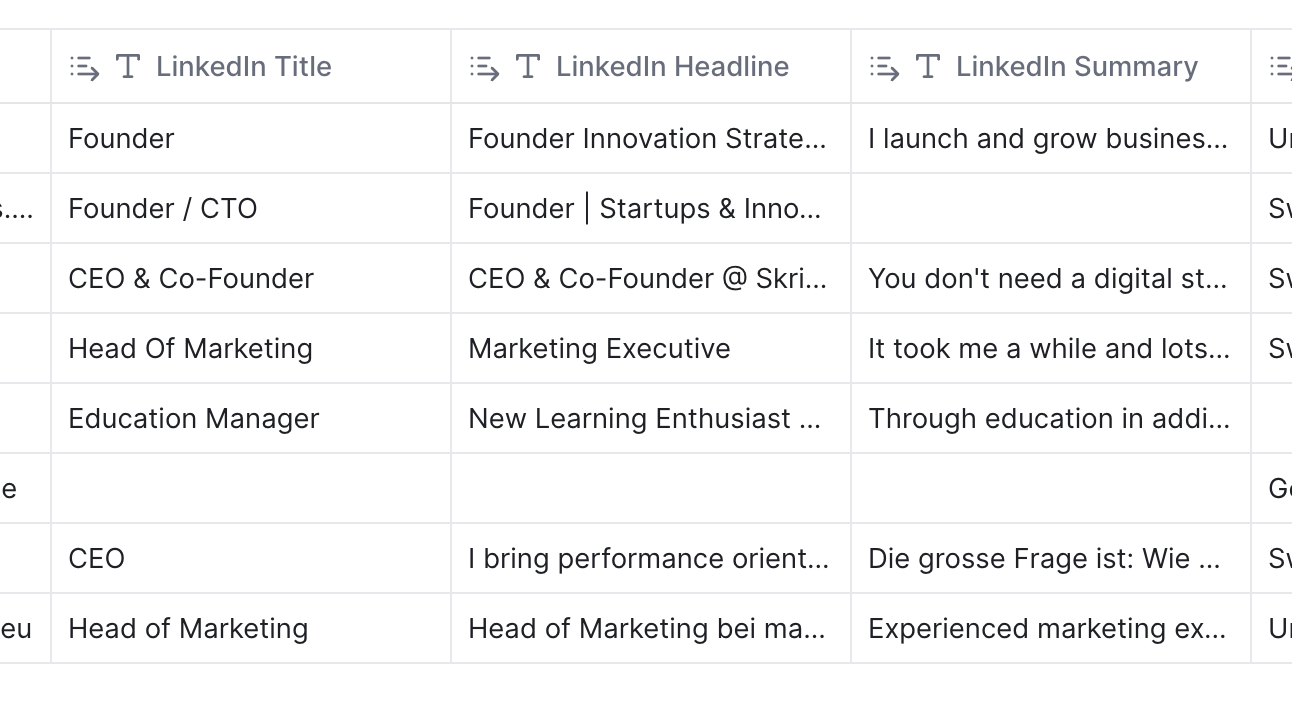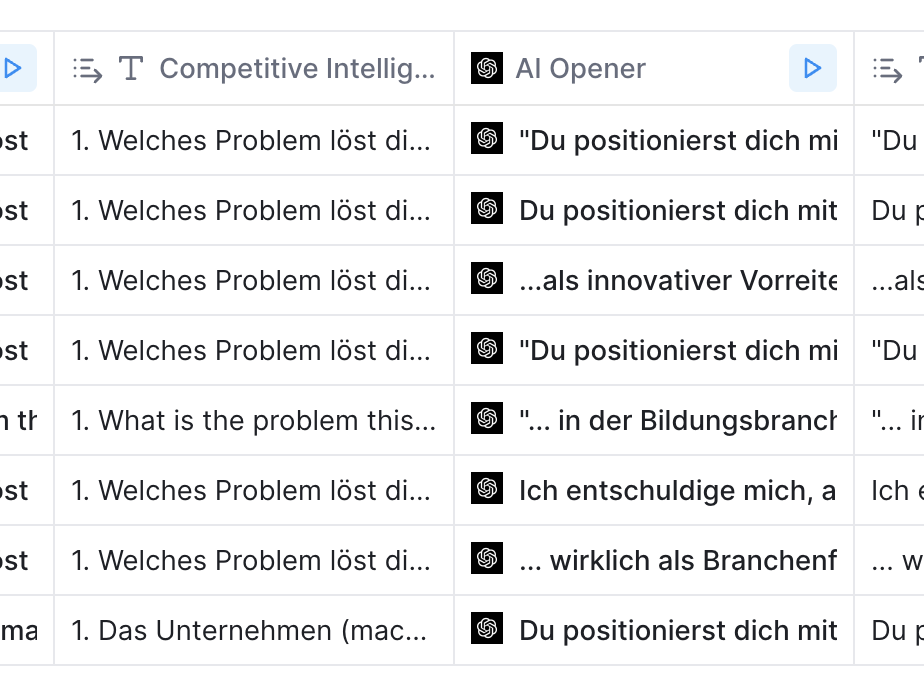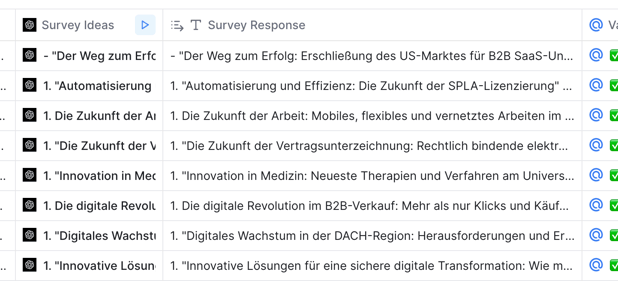Personalisation at scale: 7 Tips for the first cold email
Sending over 100K personalised cold emails in bulk throughout 2023, both for our clients and ourselves, opened our eyes to a treasure trove of best practices. We’re sharing 7 crucial tips that can 10x the engagement rate of your initial cold email to freshly scraped leads.
Listen to the podcast:
Cold email marketing is frequently a crucial source for client acquisition for B2B companies, second only to personal networking and conferences. Traditional cold emails are typically either impersonal and bulk-sent or manually sent with personalisation. But with AI, you can now combine the best of both worlds: sending personalised cold emails at scale!
7 Tips to 10x Engagement From Cold Emails
1. Make It Ultra-Personal to Grab Their Attention
While it might seem obvious, many cold emails still lack a personal touch and can easily be identified as bulk sent. If an email feels individually crafted, it’s more likely to catch the attention of the recipient and avoid immediate deletion. Personalising your introductory sentence or the opener shows the reader why you're reaching out. Even when sending thousands of emails, making each one seem personal is key.
Ways to Make Your Cold Email Personal
- Comment on their latest LinkedIn post: "I enjoyed reading your LinkedIn post about [...] because..."
- Mention a news article or corporate blog article where they were interviewed and express how it resonated with you.
- Explain why you value their company’s work, particularly if it solves a problem you've personally encountered.
The goal of personalizing the intro sentence, or the so-called "opener", is to inform the reader about why you're reaching out to them. In other words, it clarifies where you first encountered their name. Even if, in reality, you've scraped thousands of cold email addresses, each one should feel unique to the recipient. Thus, you're aiming to find ways to individualise all those cold emails.
Personalising Cold Emails at Scale
Scraping several thousand cold email addresses brings a daunting task: how to personalise each email without manual labour? Indeed, before diving into creating personalised cold emails at scale, there’s pivotal work to be done on your cold email contact list. Essentially, you need to enrich your contact list with useful information, which will be your secret weapon in crafting personalised emails later on.
We use tools like Clay, and it helps to compile spreadsheets with a variety of fragmented information about each contact. You have the capability to program an unlimited number of cells to populate with relevant details about your cold contacts, such as their current job title and LinkedIn headline. Moreover, integrating tools like ChatGPT allows you to craft specific sentences or sentence elements based on the outputs from other cells.

For instance, you can instruct ChatGPT to pinpoint the most pressing pain points of companies in areas like marketing, technology, or administration—essentially whatever sphere you’re aiming to sell to them. Once identified, that pain point, stored in a cell, will be exported as a variable in your spreadsheet.

When orchestrating your campaign, you can then weave those variables, commonly represented with curly brackets {}, into your email subject and body, providing a seamless opener.
2. Establish Your Credibility Right From the Start
Sending a personalised cold email is not just about initiating contact, but also about establishing your credibility. When you email someone who doesn’t know you, their immediate thoughts are likely to be, “Who is this? Do I know them? Is this someone important or just another random person?”
Mention Those Assets That Bring Credibility
Have you authored a book, hosted a podcast, or published an industry report? Perhaps you’re affiliated with a reputable organization in your field?
If you aim to present yourself as a credible contact and potential partner to your target audience, having one or several of these elements under your belt is crucial. They serve as tokens of your expertise and experience, and your cold contacts will be scouring for this type of information to determine whether your email merits their attention.
Take, for example, when we help our clients launch industry surveys – which inherently offer them credibility – we also provide them the opportunity to gain sponsors, like universities. Universities often seek collaborations with industries to pit their theories and models against the real-world scenarios.
Typically, they might charge between 5k to 25k to affiliate their name with your study and analyse the data for you.
3. What’s in it for Them? Make Your Cold Email Worth Their Time.
Why should the recipient care about your email? What's in it for them, your cold contact? Your goal should be to either alleviate a pain point for them or provide something they desire.
It's widely recognised that people are generally more motivated to avoid pain than they are to gain pleasure. If your research has helped you identify a pain point for the recipient, it becomes pivotal to also present a solution, providing relief.
Making Cold Emails Relevant to Each Contact, Even at Scale
In your spreadsheet, you’ll want to not only identify columns with your prospects’ pain points but also with potential solutions for relief.
For instance, our cold email campaigns target B2B companies that aspire to be the go-to expert in their industry and generate a high number of leads. To that end, we use ChatGPT to generate and store industry benchmark ideas for each contact in our database.

Later, when crafting our email sequence within our email tool, we ensure we offer value right from the start to each contact. We do this by automatically extracting the information from the cell containing those benchmark ideas.
People are more motivated to avoid pain than to gain pleasure. Therefore, highlighting a pain point you've identified for your recipient, followed by offering a solution, can make your cold emails relevant and valuable on an individual level.
4. Leave No Room for Interpretation
Your entire email needs to be exceptionally brief and crisp because, let’s face it, no one has the time. Don’t let your cold contact expend energy trying to decipher your intentions. People appreciate being directed on what to do so they can decide whether they want to do it or not. A lack of clarity will cause you to lose engagement.
In essence, incorporate a clear call to action (CTA). What should they do next? Write back? Take the quiz? Fill out the survey? Download the report? Be explicit about the singular next step you'd like them to take.
Write the Way You Speak
Envision the conversation you might have at a conference with a prospect whom you've just met. Then, attempt to transpose that conversation into your email. In other words, steer clear of formal language. Strive to keep it light, engaging, and straightforward.
5. Be Strategic about Your Outbound Setup
Embarking on outbound marketing necessitates a specialized outbound engine for your campaign to effectively function. Relying on your CRM or newsletter tools won’t cut it. You’ll often have to depend on a dedicated solution, or sometimes a combination of several tools, specifically aimed at your outbound cold prospecting.
Avoid Using Gmail
Gmail and other large email senders optimize spam filters based on your existing relationships, so it's important to use a one-to-many cold outreach tool. Research different options to find the best fit for your needs.
Protect Your Domain Reputation
Ensuring that your emails are successfully delivered and not snagged by spam filters is vital. If you dispatch 5,000 emails in a single day using your account, not only would you be blacklisted, but no emails would be delivered. Such a scenario poses a risk that your domain and perhaps other email addresses from your company might cease to function. Thus, caution is paramount.
It’s also important to recognise that outreach campaigns should be crafted iteratively, assessing what works and what doesn’t. This is a characteristic feature that a cold outreach tool should provide.
Don’t Dispatch Cold Emails via Your CRM Tool
While CRM tools like HubSpot with typical nurturing workflows enable a bit of A-B testing, they're fundamentally constructed to act according to the principle: if the customer does A, we'll do B, subsequently sending pertinent information. These workflows aren’t frequently altered. From our experience and observations, many CRM tools that include email features either violate policy or are completely averse to this practice. This is mainly because they run the risk of having their mail servers blacklisted – a situation they’re keen to avoid.
Consider having a lead automation engine outside your CRM, so that once contacts are warmed up, you can transition them into the CRM or synchronize them. This allows you to perpetually maintain the relationship thereafter.
6. Automate, Evaluate, Optimize
Navigating through email tracking can be tricky. When you track emails, recipients' mail servers tend not to be very fond of that. It makes it tougher to get through and increases the chances of being blocked. Nevertheless, we still need to know vital metrics like the open rate, click rate, and click-throughs to the landing page.
Initially, you should engage in detailed tracking, though perhaps not for the entire batch of contacts, but for a segment of it. Following that, test various elements, such as trying out 20 subject lines and 20 different body texts.
Analyze the top-performing options in terms of open rate and click rate, optimize them, and continue testing. This iterative process should continue as long as you're tracking. Once tracking is turned off, proceed with the successful variants.
7. Enhance the Deliverability of Your Cold Emails
Send No More Than 50 Emails Per Email Account
Typically, per email account, you should dispatch a maximum of 50 cold emails. Exceeding this might categorize your messages as mass emails, which isn’t optimal. This limit is what we adhere to most of the time.
Employ Inbox Rotation or Auto-Rotating Email Accounts
Understand that companies like Microsoft and Google analyse customer activity and traffic. It will feel a bit funny if you suddenly send a thousand emails from one day to the next, especially if your daily operational business only involves sending a few emails.
Therefore, it's crucial to manage your email sends in a way that is consistent, avoiding patterns that might stick out. This is achievable through rotating email accounts or what’s often referred to as inbox rotation.
Here’s how it works: if you have 30 email accounts, you distribute the list of contacts you’re targeting among them. The sequence that’s started, and the follow-ups are then allocated to an email account. This can involve multiple people, several email addresses per person, and several domains per person.

One significant advantage of this approach is that you can consolidate them into a Smart Inbox, thus centralizing responses into one primary mailbox.
Implement Email Warming
Email Warming aims to dodge pattern recognition from Google, Microsoft, or other email providers, ensuring that your emailing activity appears regular and devoid of peaks, thereby sidestepping potential red flags.
This involves sending "dummy" emails around and also testing to ensure that if an email lands in a spam folder, it is automatically retrieved. Think of it like maintaining or training your email activity, a process that can be entirely automated.
Share this
You May Also Like
These Related Stories

Perfect Your Sales Pitch with April Dunford

3 Reasons Why B2B Marketing Falls Short (and How to Fix It)
